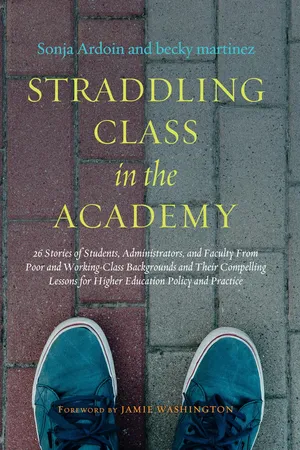
Straddling Class in the Academy
26 Stories of Students, Administrators, and Faculty From Poor and Working-Class Backgrounds and Their Compelling Lessons for Higher Education Policy and Practice
- 240 pages
- English
- ePUB (mobile friendly)
- Available on iOS & Android
Straddling Class in the Academy
26 Stories of Students, Administrators, and Faculty From Poor and Working-Class Backgrounds and Their Compelling Lessons for Higher Education Policy and Practice
About this book
" Straddling Class in theAcademy is an important book, filled with honest and powerful narrativesfrom students, staff and faculty. It expands our understanding of poor andworking class backgrounds and informs our next steps in addressing the dynamicsof social class in our college classrooms and workspaces. Read this book anddiscover truths that confirm our own reality about social class on campus, challenge us to think differently, and compel us to take action."
--Paulette M. Dalpes, Vice President of Student Affairs, Community College of Aurora"Ardoin and martinez have compiled a vital resource for all in academia. Together with their co-authors, theyprovide invaluable first-hand accounts that help readers take ownership oftheir own class identity while also providing possibility models and pathwaysfor persistence. Perhaps the largest contribution this book makes to highereducation is that it provides narratives and tools to build campuses that serveequitably across class. This book is a must-read for all in highereducation."--Peter Paquette, Dean of Students, Coastal Carolina UniversityWhy do we feel uncomfortable talking about class? Why is it taboo? Why do people often address class through coded terminology like trashy, classy, and snobby? How does discriminatory language, or how do conscious or unconscious derogatory attitudes, or the anticipation of such behaviors, impact those from poor and working class backgrounds when they straddle class? Through 26 narratives of individuals from poor and working class backgrounds – ranging from students, to multiple levels of administrators and faculty, both tenured and non-tenured – this book provides a vivid understanding of how people can experience and straddle class in the middle, upper, or even elitist class contexts of the academy.Through the powerful stories of individuals who hold many different identities--and naming a range of ways they identify in terms of race, ethnicity, gender, sexuality, age, ability, and religion, among others--this book shows how social class identity and classism impact people's experience in higher education and why we should focus more attention on this dimension of identity. A concluding chapter proposes means for both increasing social class consciousness and social class inclusivity in the academy.
Frequently asked questions
- Essential is ideal for learners and professionals who enjoy exploring a wide range of subjects. Access the Essential Library with 800,000+ trusted titles and best-sellers across business, personal growth, and the humanities. Includes unlimited reading time and Standard Read Aloud voice.
- Complete: Perfect for advanced learners and researchers needing full, unrestricted access. Unlock 1.4M+ books across hundreds of subjects, including academic and specialized titles. The Complete Plan also includes advanced features like Premium Read Aloud and Research Assistant.
Please note we cannot support devices running on iOS 13 and Android 7 or earlier. Learn more about using the app.
Information
Table of contents
- Cover
- Half-title Page
- Title Page
- Copyright
- Dedication
- Contents
- Foreword
- Acknowledgments
- Introduction
- 1 Social Class in the Academy
- 2 The Undergraduate Student Perspective
- 3 The Graduate Student Perspective
- 4 The Early Career Administrator Perspective
- 5 The Mid Career Administrator Perspective
- 6 The Senior Administrator Perspective
- 7 The Nontenured Faculty Perspective
- 8 The Tenured Faculty Perspective
- 9 The External Educator Perspective
- 10 Shared Social Class Experiences and the Intersectionality of Identity
- 11 Conclusion: Increasing Social Class Consciousness and Inclusivity in Higher Education
- References
- Authors and Contributors
- Index
- Also available from Stylus
- Backcover